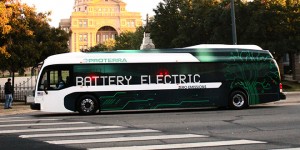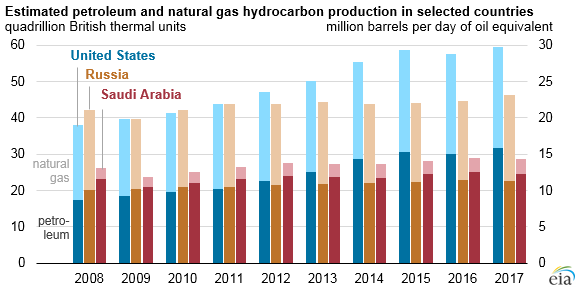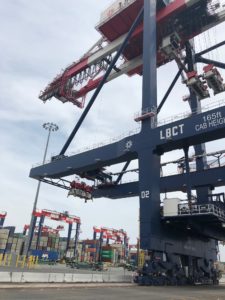 With all the focus on electric cars, it’s easy to overlook the impressive success that electric buses are having. The buses are more expensive than traditional diesel-powered buses (typically at about $700,000), but they have minimal operating costs due to low maintenance and relatively cheap electricity as fuel. As a result, they already present a strong value proposition to transit agencies.
With all the focus on electric cars, it’s easy to overlook the impressive success that electric buses are having. The buses are more expensive than traditional diesel-powered buses (typically at about $700,000), but they have minimal operating costs due to low maintenance and relatively cheap electricity as fuel. As a result, they already present a strong value proposition to transit agencies.
Electric buses also offer a significant environmental upside, both on carbon pollution and conventional air pollutants, as E&E News reported [paywalled]:
Converting the entire U.S. fleet of diesel transit buses — around 40,000 vehicles — to electric could avoid 2 million tons of greenhouse gas emissions each year, according to a recent report by Environment America, U.S. PIRG and the Frontier Group.
As transit agencies seek to retire old diesel buses, they are increasingly turning to zero-emissions technology, determining that it’s cheaper in the long run and provides significant public health benefits. Boesel estimates that around 5 percent of new U.S. bus sales are electric right now. Around 1 percent of new car sales are electric.
So not only are electric bus sales outperforming electric passenger vehicle sales right now, they are projected to dominate in the near future. Bloomberg New Energy Finance forcecasted electric buses to constitute 84% of new bus sales around the world by 2030, compared to 28% of new passenger vehicle sales by that same year.
We’ll be hosting the chief executives of two of the leading electric bus companies, Proterra and BYD, at our upcoming June 8th conference at UCLA on zero-emission freight at Southern California’s ports. Register now to hear more from them, as space is limited.
Gas prices have been on the rise, reaching a high not seen since summer of 2015:

The price increases could have both a positive and negative effect on California and the country’s transportation politics and climate policies.
First, let’s look at the price increases, which have been volatile and uneven. As the Wall Street Journal reported last week:
“The crude complex has seen prices stall a bit near recent highs as the market weighs whether a rising tide of geopolitical risk and strong demand is enough to continue overshadowing U.S. production growth to force prices steadily higher,” said analysts at Schneider Electric.
But analysts expect price declines to remain limited: the potential loss of Iranian oil from global markets might open up extra space for U.S. exports, while the market has already tightened due to falling Venezuelan output, worldwide economic growth and production curbs from OPEC members.
If the price rise lasts, it could affect some key transportation policies and efforts to decarbonize driving. On the positive side for the environment, high gas prices could:
- Boost battery electric vehicles: higher gas prices will encourage people to buy more fuel-efficient vehicles, particularly electric vehicles. That’s an all-around win for the environment and long-term efforts to transition away from fossil fuels.
- Reduced vehicle miles traveled: higher gas prices mean people will be less likely to drive as much, reducing emissions in the process and making it easier to meet our climate goals and decreasing the demand for outlying sprawl housing.
But on the negative or mixed side, higher prices could:
- Help California’s gas tax repeal measure: the California Legislature took a courageous step last year when they voted as a super-majority to increase the gas tax to pay for transportation infrastructure maintenance. Republicans have now put the tax on the November ballot as a voter-initiated repeal measure, hoping it will energize their base to come out to vote. High gas prices in November could give this measure real political life (although I’d rather see legislators investigate possible oil industry price manipulation instead).
- Possibly reduce economic output with less money for investment in clean technology: high gas prices could potentially depress sectors of our economy, which could dampen investment in clean technology generally and undermine political will to tackle environmental problems. But high gas prices in the U.S. cut both ways: while it hurts consumers, it helps oil and gas producers. And in the U.S., we’re among the global leaders in fossil fuel production, as this EIA chart shows:

So high gas prices could boost oil-producing states and the economy for those residents, which could have varied effects on those states’ willingness to pursue clean transportation policies (although admittedly probably minimal, as many of these states are dominated by Republicans and unlikely to support pro-clean tech policies anyway).
Overall, high gas prices could be a political win for most clean transportation policies and technologies, but with some potentially negative consequences as well.

Last week I had the opportunity to tour the world’s first zero-emission marine container terminal at the Port of Long Beach (see photo). The terminal uses fully automated battery electric cargo handling equipment to move containers, with more than 60 lead acid battery electric units running in every day service.
Here is a video I took of the autonomous vehicles, which are pretty mesmerizing to see move on their own:
[youtube https://www.youtube.com/watch?v=z-rJJiKNtLM&w=560&h=315]
The entire project cost well over $1 billion to build and took years to secure all the permitting, according to port officials who led us on the tour. Despite the productivity gains, port leaders seem unlikely to expand the use of the technology anytime soon, given funding constraints.
Still, the terminal is not without controversy. As I blogged about previously, the project led to a battle between labor unions and port officials, as the automations component led to longshoremen layoffs.
Ultimately, as port officials, policy makers, and advocates move toward cleaner freight at the ports, issues such as automation and workforce participation will play a major role in determining the technologies and implementation going forward.
It’s a topic we’ll discuss at the upcoming free UCLA/Berkeley Law conference on June 8th at UCLA on zero-emission freight at Southern California’s ports, featuring a keynote presentation by California Air Resources Board chair Mary Nichols. Sign up today to learn more about this and other issues related to sustainable freight at the ports. MCLE credit available for attorneys. Space is limited!
Reducing greenhouse gas emissions and ensuring environmental justice should go hand in hand. After all, residents of disadvantaged communities have the most to gain from a transition to a clean energy economy — and the most to lose from climate impacts.
Yet too often climate advocates and the environmental justice (EJ) community are at odds, particularly over policies like cap and trade and efforts to site new climate-friendly development, such as clean energy facilities, rail lines, or smart growth. EJ leaders may oppose large-scale climate policies that benefit the environment overall yet fail to protect specific neighborhoods from pollution, and they may resent changes to processes that leave disadvantaged communities without a seat at the table, among other concerns.
Given the dynamics, how can attorneys incorporate climate change concerns into their practice? Is there an ethical or professional responsibility to consider and discuss with clients the climate change implications of their decisions?
Join me at lunch today starting at 11:30am at the Alameda County Witkin Law Library for a talk on these questions. More information available on-line [PDF]. The event will take place at:
Alameda County Law Library
125 12th Street
Hayward-Union City Room, 4th Floor
Oakland, CA 94607
You can purchase tickets here for $45.00, with lunch included. One hour of participatory MCLE credit is available for attorneys. Hope to see you there!
The oil industry is wealthy and influential on transportation policy. But when it comes to electric vehicles, they have a natural — and more similarly sized — opponent in electric utilities. Electric utilities stand to make a lot of money selling electricity as fuel to EV drivers, while oil companies will lose market share in the process.
California policy makers deliberately exploited and stoked this rivalry in passing SB 350 (De Leon) in 2015, which allowed utilities to invest billions in charging infrastructure around the state. Other states have followed suit.
We’re now seeing the political fruit of that division pay off, in favor of electric vehicles. Case in point is a recent battle at the conservative American Legislative Exchange Council, which convenes conservative lawmakers and private-sector representatives to draft model legislation pushing conservative governance across the country.
Koch brothers-backed oil industry groups tried to push an effort to eliminate state incentives for electric vehicles and electric vehicle charging. But as ClimateWire reported [pay-walled], the oil industry met a worth foe:
The draft resolution, pushed by the Institute for Energy Research and backed by groups like the Competitive Enterprise Institute, opposed all federal, state and local efforts to subsidize vehicles, fueling infrastructure or fuels. That would have put up major roadblocks for states looking to expand their electric vehicle sales to meet climate or energy independence goals and for utilities looking to build the infrastructure to fuel the new cars.
The Edison Electric Institute, a trade group for utilities, fought the legislation, which was eventually tabled.
It’s perhaps just a small victory for EVs. But it points to the long-term political trend of Big Oil meeting their match in Big Utilities. While economic forces can help make electric vehicles competitive with gas-powered engines, it will also take this kind of political support to accelerate the transition — and weaken the oil industry’s hold over transportation in the U.S.
Yesterday, California and 17 other states sued the U.S. Environmental Protection Agency for its decision last month to halt Obama-era fuel economy standards for vehicles in model years 2022-25. KTVU News Channel 2 in the Bay Area interviewed me last night as part of their story on the lawsuit:
Tesla’s first mass-market vehicle, the Model 3, continues to be plagued by quality control issues. Charved EVs magazine covered the recent purchase and teardown of two Model 3 copies by Sandy Munro of Munro & Associates, a Detroit consulting firm which dismantles cars and analyzes them in painstaking detail for auto-industry clients. The results were not pretty on some basic manufacturing issues:
As others have, Munro found that Model 3 suffers from poor build quality – panels that don’t line up properly, and in one case, a door liner that seems to have been installed backwards. He also claims to have received “hundreds, maybe a thousand” emails from owners complaining about similar fit-and-finish issues. He surmises that the problems stem from poorly trained assembly line workers and (as others have noted, and Elon Musk has admitted) too much and too-hasty automation.
But the news was not all bad, particularly with Munro’s glowing account of the Model 3’s electronics and battery technology. He compared the circuit board to the “kind of technology you’d find in military-grade hardware.”
Munro also heaped praise on the Tesla battery pack, noting its high power density, superb build quality and minimal current differential between cells. “Nobody can balance batteries that close. Nobody. Nobody’s ever done that.” Munro says that Korean suppliers LG and Samsung have long been considered the best in the battery business, but that the Model 3 pack “blows them both away.”
The positive reviews in some ways underscore the frustration with the quality control challenges. Tesla’s survival as a company will depend on its ability to right this ship, as a poor reputation on quality could sink sales (and a new Bloomberg report indicates that the company could possibly run out of cash later this year, as it reportedly spends more than $6,500 every minute). While the company has thrived by bucking tradition on almost every facet of the automaker industry, its efforts to reinvent manufacturing may have been a step too far.
For more information, check out the in-depth video of Munro’s teardown above.

BAIC EC-Series, the top-selling EV in China
The Trump administration may be pulling back on clean cars, but China is all in. The latest numbers from China on passenger electric vehicles and electric bus sales are impressive, and they point to a future of global dominance for Chinese automakers in the EV world.
First, let’s look at passenger electric vehicle sales, as Clean Technica covered:
After the usual off-season (January and February), March came and electric car sales surged to 59,000 units in China, up 85% year over year (YoY). Quarter 1 2018 sales doubled compared to the same period last year, to over 122,000 units.
Consequently, the 2018 plug-in electric vehicle (PEV) share surged to 1.8%, not that far off from the 2.1% of 2017, and with sales expected to pick up significantly as the year advances, the 2018 PEV share should end north of the 3% threshold.
Last month, the Chinese OEMs represented roughly 40% of all PEVs registered globally, an impressive number that is sure to increase during 2018, possibly even beating its 46% record of last year.
Meanwhile, the Chinese EV automaker BYD had its second-best month ever with 13,100 registrations, just below their 16,000 units sold last December. Analysts expect BYD to start posting 20,000-plus performances in the second half of the year, putting it on par with Tesla’s sales forecasts.
To put those Chinese numbers into perspective, here are the most recent EV sales figures in the U.S. and California since 2011:
 So while the entire U.S. has logged 54,423 EV sales in the first 3 months of 2018 (with almost half of that total — 26,771 — from California alone), China hit 59,000 in just one month, with the trend lines only going up.
So while the entire U.S. has logged 54,423 EV sales in the first 3 months of 2018 (with almost half of that total — 26,771 — from California alone), China hit 59,000 in just one month, with the trend lines only going up.
But it’s not just passenger vehicles. China is heavily investing in electric buses. As Bloomberg reported:
China had about 99 percent of the 385,000 electric buses on the roads worldwide in 2017, accounting for 17 percent of the country’s entire fleet. Every five weeks, Chinese cities add 9,500 of the zero-emissions transporters—the equivalent of London’s entire working fleet, according Bloomberg New Energy Finance.
Much of China’s commitment to electric transportation is due to local air quality concerns. But the country’s leadership surely sees a path to economic domination of the transportation technology of the future, just as they dominate manufacturing in other industries.
While China’s commitment to EVs and electric buses is certainly good for the environment and fight against climate change, it means the U.S. federal government is missing out on a golden economic opportunity, let alone environmental one. EVs are here to stay, and at this rate, it will be China cashing in and not the U.S.
Scott Pruitt’s decision earlier this month to rollback Obama-era fuel economy standards has gotten a lot of media attention — rightfully so. In an interview last week with The Real News Network out of Baltimore, two other panelists and I had an opportunity to discuss the implications:
For those unable to watch the video, a transcript is available.
 A few weeks ago, UC Berkeley Law released the report Delivering the Goods, with recommendations for how California could achieve a more sustainable freight system. Goods movement in the state is a major economic driver but also a significant source of pollution.
A few weeks ago, UC Berkeley Law released the report Delivering the Goods, with recommendations for how California could achieve a more sustainable freight system. Goods movement in the state is a major economic driver but also a significant source of pollution.
To accompany the report release, the Center for Law, Energy and the Environment (CLEE) at Berkeley Law held a webinar to highlight key findings. The discussion featured these experts:
- Elizabeth Fretheim of Walmart
- Adrian Martinez of Earthjustice
- Chris Schmidt of Caltrans
Video from the webinar is now available, for those who couldn’t attend at the time or would like to review portions:
And if you’d like to learn more about sustainable freight at Southern California’s ports, please register for the free June 8th conference at UCLA on the prospects for deploying zero-emission technologies there, featuring experts from industry, government and advocacy groups.


